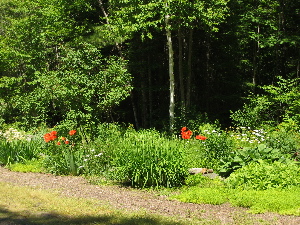PRUNING RASPBERRIES
Mia had a question about pruning raspberries, and when that should be done. Here's an article from the New Hampshire Extension Service about this topic. I thought I'd include the entire article because it addresses a number of important issues with raspberries.
"Pruning Raspberries
Pruning is a vital part of maintaining a healthy
raspberry planting. This practice greatly inhibits the
spread of raspberry diseases and improves fruit quality
and yield. Pruning red raspberries should begin
immediately following harvest by removing all the canes
that fruited. This improves light penetration and air
circulation of the canes that will fruit next year. Also,
remove any new canes that are growing outside of the
12-to-18 inch row width, or show obvious symptoms of
insect or disease damage. In the spring before the buds
break, thin remaining canes, leaving only four to five of
the sturdiest per foot of row. Spread the canes that are
left onto the wires of the trellis and tie them with twine or
some other soft material.
Everbearing or fall bearing red raspberries bear a late
season crop on first- year canes. If they are pruned in the
same manner as the summer bearing types, they will
bear two crops per season; one in the summer on the
second-year canes, and one in the fall on the first-year
canes. Everbearing raspberries are usually managed
to produce only the fall crop. Simply mow the canes
down early each spring. During the summer, cut down
any new canes which develop outside the 16- inch row
width and thin the remaining canes to about six inches
apart, leaving the sturdiest. This technique greatly
reduces pruning labor, but also eliminates the summer
crop. Unfortunately, most everbearing cultivars, such as
Heritage, produce the fall crop too late in the season to
escape damage from frost in most of northern New
England.
For black and purple raspberries, pinch off the top four
inches of new canes when they reach about three feet in
height. Blackberries should be pinched when they reach
four feet. This encourages these canes to form side
branches, or laterals, which will bear fruit the following
year. Remove all canes that fruited immediately following
harvest. In the early spring, thin remaining canes,
leaving only five to seven of the sturdiest per hill. Cut
side branches back to 12 buds (usually about 12 inches
in length) and tie the canes to the wire or post for support.
Remove all plant waste from the field after pruning and
destroy it, preferably by burning. Leaving dead canes in
the planting will encourage the spread of disease."
If you are interested in reading more about Rasperries, here is a link that will take you to the entire article.





0 Comments:
Post a Comment
<< Home